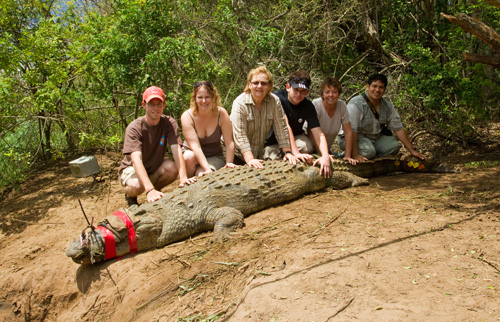Sorry for the lack of post and pictures…it’s been quite the busy time here!
–
At the end of October the volunteers along with myself got to take part in an amazing experience. We were teamed up with a couple of students studying for their PhD’s here in South Africa, Xander from SA and Jon form the US. They have been doing field research for a few years and have a couple more left. They are studying a few different aspects regarding the Nile crocodiles here in this part of South Africa. Numbers of the crocodile have been dropping dramatically. Half of the population in The Kruger have now vanished, most likely due to water pollution. Even though here in iSimangaliso Wetalnd Park there is approx. 1200 adult crocodiles, it might not be the case for long, as the area has been in drought for years now, and food sources are getting scarcer as well as increased poaching, pollution and habitat destruction. Because of the state of the crocodile, which is currently listed as least concern on the red data list as of 1996, but is now closer to threatened, Xander and Jon have been doing field work for specifics purposes. Xander is studying the population dynamics of the species. How this is done is to catch the crocodiles, place transmitters on some, and tag others, following movements, nesting patterns, etc. Jon is taking a look at what the crocodiles are eating, as well as level of toxins in their blood, such as lead, since St. Lucia was and is such a big fishing area. Crocodiles are the top predator in the area, so it is important to know as much about them as possible, their movement pattern, feeding behaviour, what is passing through to them in terms of pollutants and toxins.
–
In the following set of pictures, I have documented what goes on when they catch a croc and what test and measurements are taken. Some of the photos might look bad or harmful to the croc, but it definitely did not hurt it and was necessary to obtain the data they require, which will in turn help the protection of this amazing reptile. Firstly they had caught the crocodile in a simple bamboo snare with bait, very primitive in nature, but got the job done. After the croc was attached the mission was to get this large reptile out of the water to preform the required tests. First you see Xander and Jon tying the back legs so when he got on the land he could not run anywhere. You can see Jon covering the eyes; this is done to reduce stress to the animal, when he cannot see, he calms down and it’s almost like nothing is happening. Next we had to haul this thing out out the water…6 or 7 people could not pull it out, due to the size and angle of the bank. Had to resort to the good old block and tackle, and slowly cranked this croc out onto the flat surface. The first thing needed was to secure to mouth, multiple zip ties as well as duct tape and the rope got the job done. Blind fold was placed on, then about 3 or 4 people were needed to sit on top of the croc to prevent him from moving about. The first tests was to take some blood samples, usually taken from the neck, but in this case due to the size of the animal, they went in through the tail. Took a healthy portion of blood to test for toxins, as well as certain isotopes. Next was to cut some of the scutes off (the sharp tips of the tail) This was to test for what the animal is eating, especially important here since the drought has caused the crocodiles main prey, fish, to decrease tremendously. Also serves as an indicator of which croc this is, so they cut specific scutes off. Next was to tag the crocodile. Each croc has a specific tag of 4 colous, so they can be easily identified and not recorded twice. This is done by placing them through the tail, which has very little feeling, so the crocodile hardly felt the tags being placed on. Next came all the measurements, of length and width etc. Next was an interesting mission to hoist this croc up to weigh him. Again pulling out the block and tackle this was achieved. This croc was 4.116m long and 287kg, their biggest recorded on the project.
–
Definitely not something you do everyday, it was an amazing experience. Enjoy the photos everyone!


























This is absolutely amazing! Great photos and interesting commentary so we know exactly what is happening. This animal is beyond words…so prehistoric and HUGE. What a lucky kid you are and what an experience!
By: mom on November 13, 2010
at 11:29 PM
Wonderful photos, Sean! I love the whole lesson that accompanied the photos – a great photo journal. I agree with your mom … what an incredible experience and opportunity!
By: Patty Arsenault on November 18, 2010
at 9:50 PM
Sean – amazing shots. That was an experience of a lifetime for most anyone. You were right on top of it all – I remember so clearly. You worked so hard and your facial expressions. Still so clear in my mind. I even have some shots of you looking a bit “scared”. Jon kept calling for your help and you were always there to do as asked. My point being that you could have just been obsessed with your camera but you were focused on the job at hand and then went on for the documentary. Well done and a true love of nature.
By: bea on March 1, 2011
at 1:18 AM